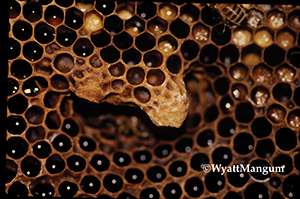
Naturally-built, well-constructed queen cells from good bee breeding stock can be a source of new queens in a beekeeping operation. To use these queen cells, beekeepers should know to how judge good queen cells from poor ones, how to cut queen cells from combs, how to transport queen cells between apiaries, and how to reattach queen cells to the combs of the recipient colonies. With the high cost of queens, these skills would be very beneficial for beekeepers to produce some queens on their own.
As part of our general biology of queen cells, let’s briefly review some basic queen cell biology and beekeeper terminology. Queen cells occur naturally under three conditions: when bees prepare to swarm, to supersede a failing queen, or from emergency queen loss. Queen cells reared under these three conditions are referred to respectively as swarm cells, supersedure cells, and emergency queen cells. When swarming, bees build numerous swarm cells near the edge of the brood comb. There are plenty more swarm cells over the face of the comb, most likely in locations where queen cells will fit between the combs. In contrast, bees superseding their queen typically build a few queen cells near the central region of the combs. The two categories can be nebulous. A colony, typically in the spring, can start out with a few supersedure cells and later on use them to swarm.
Swarm or supersedure cells usually begin from queen cell cups. A queen cell cup is a precursor of a queen cell, consisting only of the cell’s base and about a third of the cell’s wall (see Figure 1). Queen cell cups are usually present in the brood nest for most of the active season; however, they are generally empty except during swarming and supersedure. When containing a fast-growing queen larva, the bees build the queen cell cup into a queen cell (see Figure 2). In contrast, if the queen dies suddenly, the bees are forced to begin the emergency queen cell by enlarging a worker cell containing a young larva. Unlike the queen cell structure in Figure 2, emergency queen cells have cavities extending to the original worker cell floor (the foundation). As we will see later, this deeply rooted cavity presents a difficulty when removing an emergency queen cell from the comb.
From egg to adult, the queen develops in about 16 days. Although the larva is female, the production of an adult queen or worker is determined by the larva’s diet. The diet for queen formation is commonly called royal jelly and differs from the larval diet of the worker bee larvae. When the nurse bees finish provisioning the queen cell with royal jelly, the bees build a wax dome-shaped cap across the cell’s opening. Now the cell is referred to as a “sealed” queen cell (see Figure 3). For about a day after her cell is sealed, the queen larva continues to feed on stored royal jelly, quite unlike the worker and drone larvae who do not have anything like this massive food reserve. Before transforming to a pupa, the queen larva spins a partial cocoon (concurrent with post-capping feeding). A queen cocoon is quite unusual because it does not completely surround the queen pupa. The cocoon extends across the cell’s cap and up the sides, but not across the base of the cell, which would separate the queen larva from her food supply (see Figure 4). Prior to the queen’s emergence, typically the bees will remove most of the wax cap and expose the end of the cocoon (see Figure 5). The presence of an exposed cocoon can be used to distinguish a queen cell that has been sealed for some time from a newly sealed cell (with a wax dome). Besides wanting some indication of when the queen will emerge, newly sealed queen cells should not be handled. Apparently the spinning larva is quite susceptible to temperature fluctuations and physical shocks. When the queen is ready to emerge from her cell, the queen cell is referred to as a “ripe” queen cell.
When learning about queen cells, we see them in one particular way, which is so obvious, it becomes subtle, and then beyond question. We see queen cells in reflected light. To better reveal the structure of queen cells, let’s look at queen cells in transmitted light, where the light comes out of the queen cell (transmitted through the cell). In Figure 6, I have removed the contents from a sealed queen cell, installed a small light source, and photographed the queen cell in the dark. Now the braided pattern becomes more pronounced. The random ridges of wax appear woven around the sides of the queen cell. The pits on the queen cell glow because their bottoms are just the queen’s cocoon and some thin wax. The cap end of the cell glows brightly because it is only the queen’s thin cocoon since the bees removed the wax cap (and my little light source had more light aimed to the cap. Currently, I’m looking for a better light source, subject to several technical parameters.) When the queen emerges, she has only ….


